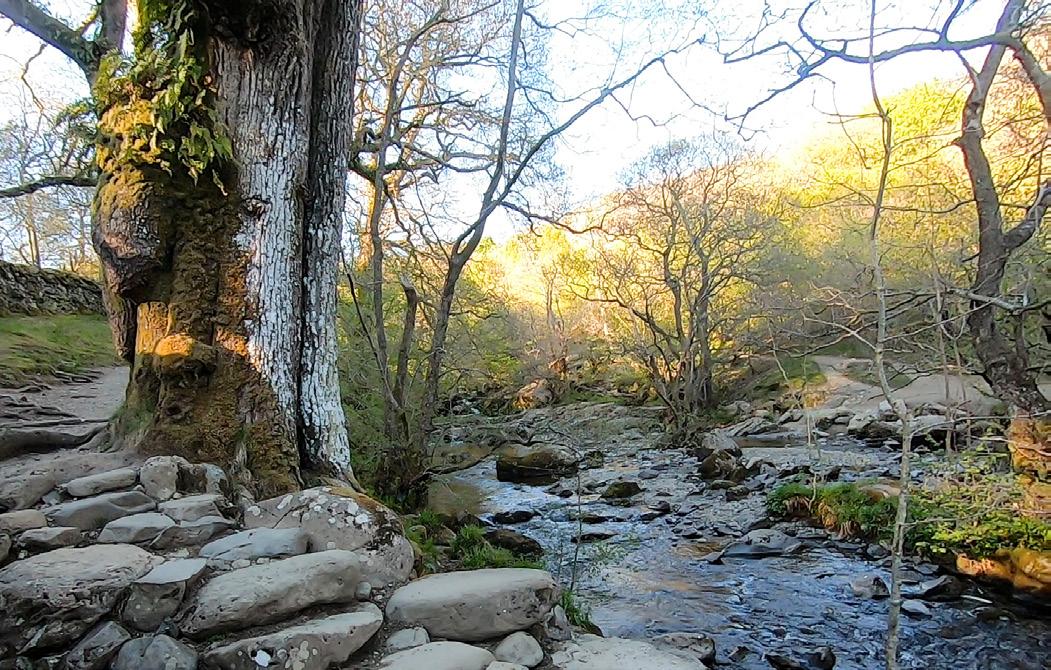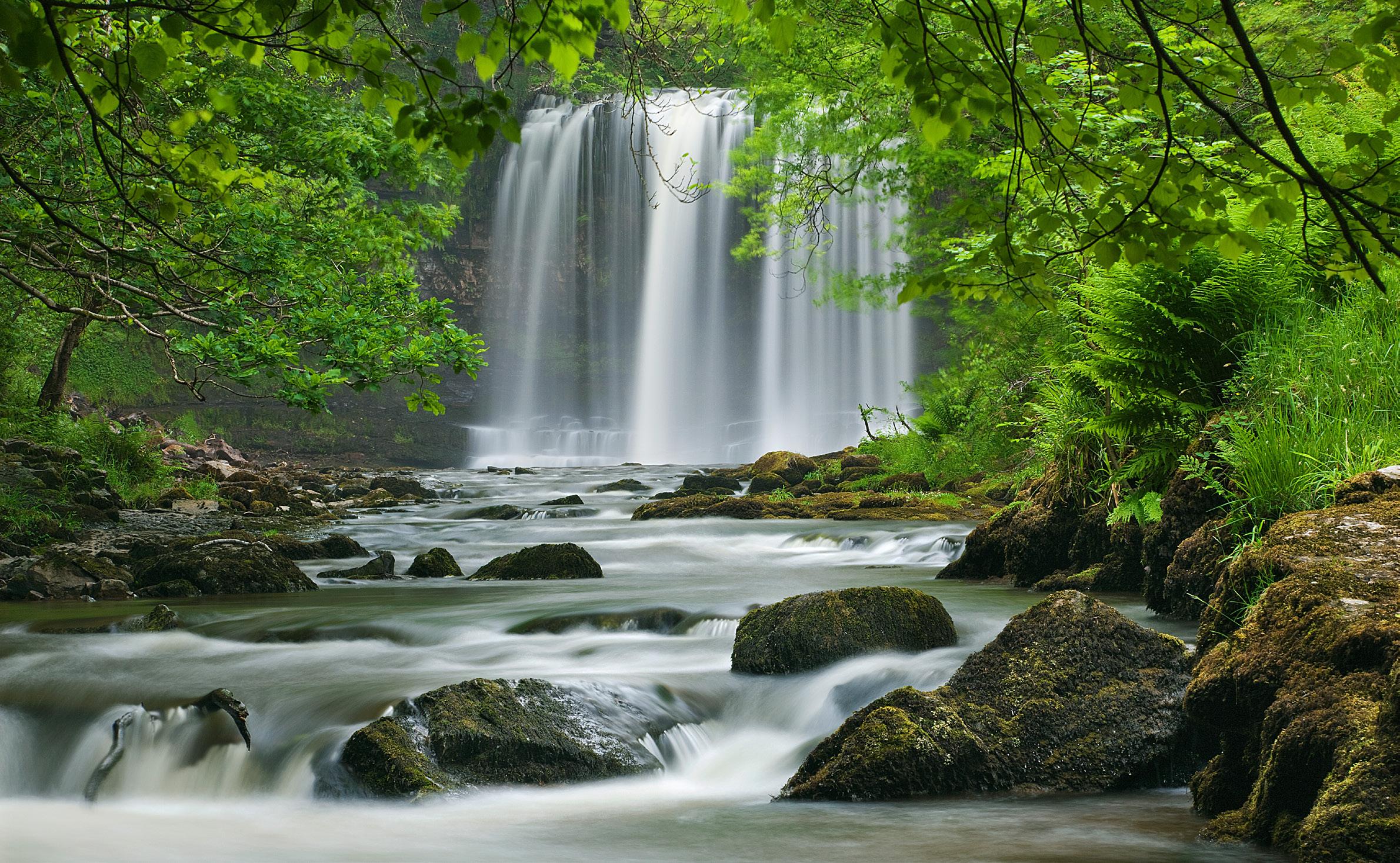
9 minute read
The Wonder of Waterfalls
Beautiful to behold, the frothing, fizzing, foaming flow of a waterfall is one of nature’s most impressive spectacles. Here are some of Britain’s best...
Standing by a waterfall, watching the endlessly falling whitewater and listening to that rushing, roaring, thundering sound, in awe of its power, is an uplifting experience. And it’s beneficial, too.
The air around waterfalls has the highest concentration of negative ions found in nature. These are atmospheric molecules charged with electricity, and exposure to them can ease stress, regulate mood and even reduce depression.
Watching the unceasing cascade down is mesmerising, as is the ‘white noise’ sound, used in sleep apps for its soothing and relaxing properties. Although the water flow may not be at its fiercest in the summer months, it’s the best time to be spritzed with that fresh, cooling spray –and to enter the world behind the waterfall and gaze out through that misty curtain.
North England
Thundering 65ft down a craggy rock face is Aira Force in Cumbria, formed by Aira Beck (stream) making its way down the fells to Ullswater. ‘Force’ or ‘foss’ comes from the Old Norse word for waterfall. Follow the waterfall trail from the National Trust car park for the best view of the walls and the two stone bridges arching over the plummeting water. In the 1780s the Howard family of Greystoke Castle landscaped the area around the Force, planting over half a million trees, and creating a network of bridges and paths. Around a quarter of a mile higher up is another fall, High Force.

Aira Force
Much more impressive than its more westerly namesake is County Durham’s High Force. This awe-inspiring 70ft cascade, where the River Tees plunges over a vertical cliff of blocky whinstone, is the UK’s largest volume of water falling over an unbroken drop, when in full spate. The stunning view was painted by JMW Turner in 1816. The north side is privately owned and you have to pay to walk to the falls, but approach from The Pennine Way on the south side for free access. Walk around two miles from Bowlees Visitor Centre, across the suspension footbridge, to go along the river via Low Force – as the name suggests, not as high! – up to High Force.

High Force
Image shutterstock Andrew Swinbank
The easy-to-follow walk to Hareshaw Linn (‘linn’ is old dialect for waterfall), near Bellingham in Northumberland National Park, passes through a formerly industrial landscape, now reclaimed by nature. The path winds up the damp, deep gorge, lush with ferns, mosses, liverworts and lichen cloaking damp boulders and branches, crossing Hareshaw Burn, a tributary of the North Tyne, via six bridges, offering beautiful views of the bubbling burn beneath. By the sixth bridge there is a tree stump studded with coins, for good luck. Follow the sound around the bend, down stone-slab steps to the Linn, tumbling down over the 30ft sandstone cliff to the pool below.
The Peak District National Park has plenty of waterfalls. Fair Brook flows down the lower slopes of Kinder Scout, the region’s highest point at 2800ft (famed for the ‘mass trespass’ of 1932, when walkers took to the hill to protest against lack of access), with several waterfalls as well as natural pools – some deep enough for a dip if you fancy a wild swim as well as a walk. Kinder Downfall is the region’s highest waterfall, at 98ft. Its flow can be temperamental, but in windy conditions it appears to flow upwards!
South West England
On the North Devon coast near Hartland, and accessible on foot via the South West Coast Path, you can enjoy the rare, spectacular sight of white, tumbling waters on a coastal cliff. In a ruggedly beautiful area of hanging valleys and high cliffs, Speke’s Mill Mouth waterfall drops 157ft over a sheer cliff edge, then tumbles downward over boulders onto the rock-slabbed beach to meet the sea.

Speke’s Mill Mouth waterfall near Hartland Quay in North Devon, England
Image credit Marius - stock.adobe.com
At the head of the Bride Valley in Dorset lie the thatched cottages of the picturesque village of Littlebredy. (It really is little, too: population around 100.) As part of Bridehead House’s 19th-century garden redesign, the river was dammed to create a lake and from here it flows through the grounds then gushes noisily over a drop.

Little Bredy waterfall and Rhododendrons
Image credit allouphoto - stock.adobe.com
Pack a picnic to enjoy on the expansive adjoining grassy area, then paddle in the river. Scramble up behind the fall to gaze over the lake and snap the perfect shot from the little stone footbridge behind.
South East England
The southeast of England is not renowned for its mountains, so waterfalls are, naturally, hard to find. The next best thing is the constructed Grand Cascade within the grounds of Blenheim Palace, designed by the renownedly naturalistic landscape gardener Lancelot ‘Capability’ Brown in the 1760s. Now a Unesco World Heritage Site, it forms part of a complex dam structure at the western end of the lake he created across the estate, with a delicate arched bridge offering the perfect photo opportunity. Home to the Dukes of Marlborough, Blenheim is the former home of Sir Winston Churchill, who was born here.

Taking in the Grand Cascade, in the grounds of Blenheim Palace
VisitBritain/Pete Seaward
Scotland
We may have poet Robert Burns to thank for the gorgeously wooded landscape at the Falls of Bruar at the southern edge of the Cairngorms National Park, in Perthshire. When he visited in 1787, Burns found the surroundings somewhat bare and was inspired to write The Humble Petition of Bruar Water to the landowner, the 4th Duke of Atholl. Written from the water’s viewpoint, it entreats: ‘Would then my noble master please/ To grant my highest wishes/He’ll shade my banks wi’ tow’ring trees/And bonie spreading bushes.’ The Duke took Burns’s advice and, in an innovative forerunner of modern seed bombs, he fired Scots pine and larch seeds from the opposite bank from a cannon. The lowest fall of peat-brown water through the forested rocky gorge has an arched stone bridge, and a natural rock span just downstream.
Around the Falls of Clyde in this species-rich wooded gorge, near New Lanark, southeast of Glasgow, you might spot kingfishers, dippers and ravens, with swooping bats, badgers and even otters. But the main attractions are the four waterfalls within four miles. At 88ft high, Corra Linn is the second one you’ll see, and the most spectacular. It was described by William Wordsworth as ‘the Clyde’s most majestic daughter’. Located by the falls is the most famous Scottish country clothing brand, House of Bruar, which houses a fabulous food hall perfect for picnic essentials.

Bruar Falls
Image credit Jacob Booth

The Falls of Bruar
VisitScotland / Kenny Lam
Just upstream is Scotland’s first hydroelectric power station, harnessing the power of the falls to power textile mills in New Lanark, completed in 1927.

Amazing sunset at the Fairy Pools, Glen Brittle, Isle of Skye, Scotland
EyesTravelling - stock.adobe.com
On the Isle of Skye beneath the Black Cuillins are the famous Fairy Pools. This series of small falls are renowned for colour and clarity: turquoise so clear that you can pick out mossy pebbles in the depths. Some are swimmable –brrr! Further north is Mealt Falls, which cliff-dives from Loch Mealt to the rocky coast below. From here you can also see Kilt Rock, with its pleated-effect basalt folds.

Mealt Falls and Kilt Rock
VisitScotland / Richard Elliot
Northern Ireland
Near Ballymena, Co Antrim, in Glenariff, largest of the nine glens of Antrim, are no fewer than nine viewing points for three waterfalls on a choice of four walking routes. All are clearly waymarked, with wooden fenced boardwalks incorporating flights of steps that allow close-up views of the falls, where white froth and foam contrasts against the dark waters, the lush foliage lining the gorge, and possibly even local wildlife such as red squirrels, hen harriers and Irish hares. At the top of the walkable area enjoy more expansive views down to the Irish Sea and across it to the Mull of Kintyre in Scotland.

Glens of Antrim
Wales
In Bannau Brycheiniog (previously known as the Brecon Beacons) National Park is an area known as ‘waterfall country’, with Britain's greatest concentration of cascades, caves and gorgeous gorges. The Four Falls Trail takes in Sgwd (Welsh for ‘waterfall’) Clun-Gwyn, Sgwd Isaf Clun-Gwyn, Sgwd y Pannwr and Sgwd yr Eira. The last, which means ‘waterfall of snow’, is the best known, most popular, and the most photographed – not least because you can experience the thrill of walking behind the cascading curtain of water. Be prepared: you’ll almost certainly get wet on the rough and slippery path used by sheep farmers – but it’s worth it!

Sgwd yr Eira
Image shutterstock Billy Stock

Pistyll Rhaeadr
Image © Crown copyright (2017) Visit Wales
Pistyll Rhaeadr, meaning ‘spring of the waterfall’, lies in the Berwyn Mountains, just inside Wales, in Powys, west of Oswestry and Shrewsbury at the end of a narrow singletrack road. At 240ft high, it’s often hailed as Britain’s highest single-drop waterfall, although some argue that the drop is in three stages… Either way it’s a breathtaking sight: a narrow white ribbon falling behind a water-hewn stone arch. From the top you can see Snowdonia to the west and the hills of Shropshire to the east.
Text by Adrienne Wyper










